TWO MONTHS BEFORE HIS 89th BIRTHDAY, a man steps out of a black BMW into New Delhi’s winter sun and bends down near the tall, ornate, wrought iron gates that have been kept open for half an hour. Captain Chittarath Poovakkatt Krishnan Nair—59 years after leaving the Indian Army, he is still Capt. Nair to everyone—chairman and patriarch of India’s Rs 450 crore Leela chain of hotels, examines two metal bumps with explosives detectors that scan the underside of cars. “Too high,” he frowns. “Too high. A guest should not feel the bump when his car goes over it.”
Surrounding Nair are four executives. To his right is vice president Shashank Warty, who was part of a team that launched two hotels and six signature restaurants for Indian Hotels (the Taj group) and has been with the Leela for the past three years. To Nair’s left, standing in a row, are vice president, operations, Thomas Lind (ex-Four Seasons); general manager Charles Morris (former general manager, The Peninsula, Bangkok); and Rajeev Kumar Mangalat, horticulturist for nearly three decades to the famously green-loving Nair, who made plumeria petals his group’s insignia. This is the entrance to The Leela Palace Kempinski New Delhi, a 260-room hotel in the capital’s tony Chanakyapuri area, scheduled to open in early 2011. A limited opening preceded the Commonwealth Games in October 2010.
For the next 45 minutes, Nair discusses cars, suspensions, bumps, and how they fit into a luxury hotel’s scheme of things even as two women from the front desk wait to welcome him with the traditional garland. He keeps switching between exuberance and anxiety. “Oh, look at these gorgeous elephants!” he says, walking briskly towards the hotel’s sculpted facade, ignoring the Bimmer waiting to ferry him up to the door of the hotel. Elephants are a recurring motif across his hotels, including the property at Delhi.
“What are visitors coming to my hotel for?” he asks his team. It’s a question they hear often.“They are coming …” he pauses—and one gets a sense that this dramatic pause, too, is often repeated—before adding, “for the essence of India.”
“But you all are ruining it!” Nair wags his finger at rows of black marble fountains in the main lobby with no water in them. “Why is there no water? Why isn’t the landscaping complete? Why is the marble not completely clean? Left to you all, the hotel will not open for another year.” The group around him has now shrunk back a few paces while Nair continues: “Just waiting and waiting. I want to open tomorrow!”
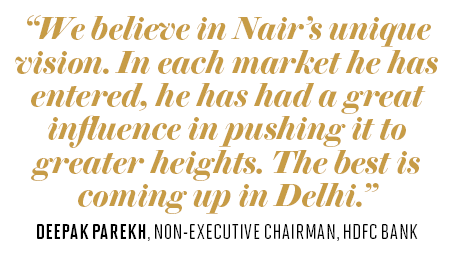
Like all legendary luxury hoteliers—think Conrad Hilton, George Boldt (Waldorf Astoria), and closer home, P.R.S. Oberoi—Nair wants his hotels to be a reflection of his interpretation of luxe. But this time, he wants to surpass even himself by creating what could end up becoming India’s most opulent hotel chain. First up will be the Delhi property. Then there’ll be others in Chennai, Agra, and Ashtamudi in Kerala.
This desire to create India’s most magnificent hotels, and recast what the Leela group stands for, masks another deep yearning—revising his legacy. Nair is seen as an excellent hotelier, but the mantle of being India’s best still eludes him. That belongs to the Taj group, and more to the father-son duo of M.S. Oberoi and P.R.S. Oberoi. Asked whether he wants to challenge their legacy, Nair smiles. “Yes. If you are asking me if I want to be remembered as the luxury hotelier in India, then yes,” he replies.
Nair certainly has the finances. The Delhi hotel costs Rs 1,700 crore, including the three acres of land for Rs 700 crore. The average cost per room works out to Rs 6 crore. There are 260 rooms where 400 could have been built. The investment in the upcoming hotel in Chennai is another
Rs 700 crore. The Leela group has piled up debts of Rs 3,351 crore (on equity of Rs 2,082 crore), which has skewed its debt-equity ratio to 1.6:1. Generally, 1.2:1 is considered comfortable for hotels.
Some wonder if this is an old man’s obsession with a last hurrah. “It’s an ego project,” says a veteran hotelier with a major international chain. “The Delhi hotel is intended to make them a major player, but is it sound business? That is questionable. The back-of-the-envelope norm is that you must get one rupee in room revenue for every Rs 1,000 invested. Will the revenue come in?” Here’s the math: the hotel in Delhi will need to charge at least Rs 22,000 a night per room to break even. Delhi’s most luxurious hotels, such as The Imperial, charge an average of around Rs 17,000. (These are different from the rack rate, which at The Leela will be Rs 30,000.) “Capt. Nair is trying to do the impossible,” the hotelier adds.
Leela’s principal banker differs. HDFC Bank non-executive chairman Deepak Parekh, who has known Nair since he was a boy (and Parekh is 65 now), says the bank has been happy to support Nair all along. “We believe in his unique vision. In each market he has entered, he has had a great influence in pushing it to greater heights. And the best is coming up in Delhi.”
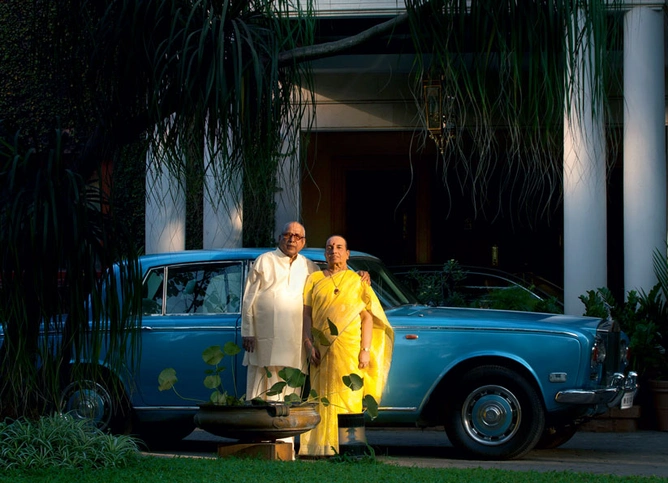
THE CAPTAIN'S SON VIVEK, Leela’s vice chairman and managing director, says the industry hasn’t quite figured out its objectives. “Our aim is not to have many hotels but to have the hotel with the highest revenue per room in every market,” he says.
It’s the only way the Leela group can compete. It has seven properties, including a hotel in Gurgaon that it runs on a management contract. In addition, there are the four upcoming ones scheduled to open by 2015, including the Delhi hotel. But the chain is dwarfed by the Taj’s 66 hotels in 42 locations in India (some cities have multiple properties), and 16 overseas. The Oberoi group has 11, which includes the fabled Vilas properties (Rajvilas, Amarvilas, and the like).
According to Nair, his mission is “to build the ultimate luxury hotel chain in India”. But he quickly corrects himself, saying: “To build the ultimate Indian luxury hospitality group in the world. When everyone says it cannot be done, I just do it.”
Gourang Shah, assistant vice president at stockbroking firm Geojit BNP Paribas, says he is bullish on Leela. The stock is hovering around Rs 43. “I have a firm buy on Leela. The family is very strong and it has properties coming up that seem like market leaders in their category.”
Nair’s father was a village clerk in Kerala’s northern Kannur district who collected taxes and rent on behalf of the local authorities. He was 13 when the local raja visited his school. After the king made his speech, Nair broke all rules—as he does even today—to run to the stage and recite a poem that compared the raja’s grace to a thousand suns and moons. It won him a scholarship for the remaining school years.
This sense of grand and enlightened spin doctoring is the leitmotif of Nair’s story—a man who named his hotel chain after his wife and, as everyone say, only truly listens to her. “At 30, Leela asked me, ‘Why do you want to spend your life saluting someone else?’ So I plunged into textiles. It made me very wealthy,” he says. He quit the army to start his first business as a textile exporter—his in-laws had a handloom business. But almost immediately he faced a setback—the Madras plaid cloth which he exported bled colour. He had to face furious customers and even legal action in the U.S.
He got out of that mess with characteristic panache. In 1958, he joined hands with Brooks Brothers to announce Bleeding Madras—a wondrous fabric that came with a unique guarantee: bleed it would. By the time Leela Lace Holdings was finally sold off in 2007, it had a turnover of $75 million (Rs 337 crore) and boasted clients such as Tommy Hilfiger, Liz Claiborne, Wal-Mart, and Macy’s.
Leela Lace made Nair a multimillionaire by the time he was 65. He had moved to Mumbai from his hometown Kannur, and had built his house in Sahar, 1.5 kilometres from the site of Mumbai’s new, yet-to-open international airport. But Nair was not ready to retire.
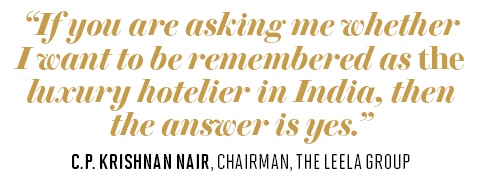
So, one day in 1981, when his wife Leela pointed out that a taxi stand for the airport was coming up next to their house, it set him thinking. “Why should visitors take a taxi and travel 30 kilometres to a hotel?” In those days Mumbai’s two big hotels were the Taj Mahal and The Oberoi, both roughly 30 kilometres from the airport. Nair was the first to spot the need for quality accommodation close to the airport.
He bought 11 acres of land near his house and began building his first hotel. The architect he hired wanted to remove much of the area’s natural greenery for a clean, international look, but Leela insisted it remain, especially her favourite century-old banyan tree. “She said, ‘No
banyan tree, no hotel’,” says Nair. The tree stayed, but not the architect.
The Leela Kempinski Mumbai opened in 1986 and was a smash hit. “It was a very different city then,” says poet, author, and longtime Mumbai resident, Anil Dharker. “All hospitality and entertainment at that time was centred in south Mumbai. Everyone used to drive there from the suburbs for entertainment. And here was a man who was building his giant hotel in the middle of nowhere when the airport was not even ready,” he adds.
Nair’s contrarian bet paid off. “Everyone had scoffed at the idea and thought it was ridiculous,” he says, over vegetable dumplings at The Great Wall, the Chinese restaurant at The Leela Kempinski Mumbai.
In 1991, he went against the tide again, this time opening a hotel in south Goa, when all others were in the north.
By 1997, Nair had trained his sights on Bangalore. As a boy, he was awestruck by the opulence of the Mysore Palace, owned by the Wodeyar dynasty. But, being a commoner, he never managed to gain entry. After he opened the Mumbai hotel, Ramakrishna Hegde, Karnataka’s then chief minister, invited Nair to the palace. “I was thrilled. He told me, ‘Nair, why don’t you build a hotel like this palace in Bangalore? A modern palace.’ That idea stuck in my head,” says Nair.
Nair’s architects took 2,000 photographs of the Mysore Palace from all angles. He then built The Leela Palace Kempinski Bangalore as a homage to what the Wodeyars had created.
“He has always been able to think bigger and ahead of the curve,” says Ajay Bakaya, executive director of Sarovar Hotels and Resorts. “Be it in Mumbai or in Bangalore, people have always questioned his decisions, but each time he has been proven right.”
Bangalore resident Arun Pai, who runs the city’s famous Bangalore Walks, explains the significance of what Nair did. “What was here [Airport Road] before The Leela Palace Kempinski Bangalore opened? Nothing. Just a swamp. And Bangalore was the quintessential city for retired bureaucrats. When The Leela opened with 357 rooms—more than the combined rooms of The Taj West End and The Oberoi, Bangalore—everyone thought it was crazy.” Bangalore in 1997 was on the cusp of the tech boom; when the boom happened, The Leela was all set to host executives of global IT companies.
By 2009, Nair opened two more properties, in Kovalam, Kerala, and Udaipur, Rajasthan.
But his grand dream, in his own words to Lind, is to build an Indian version of the Four Seasons. Lind recalls Nair telling him, “not quite the Four Seasons, but I want to be known for the highest level of personalised service that the words ‘Four Seasons’ imply in the world of luxury”. Part of the dream could perhaps be attributed to the history Nair shares with the Four Seasons.
FOUR SEASONS' LEGENDARY OWNER Isadore Sharp, in his book Four Seasons: The Story of a Business Philosophy mentions Nair in a chapter titled ‘A Few Bad Apples’.
He writes that he met Nair in 1994 when The Leela had two hotels—Mumbai and Goa—and entered into a contract to run a chain of five-star hotels with Four Seasons branding. He claims Four Seasons helped The Leela refurbish the Goa hotel, but just before its reopening, Nair backed out.
“I was shocked by this sudden, unexpected turn of events—though we had seen signs that the Leela group was then overextended,” writes Sharp. “Sometimes, thinking back … I cannot make up my mind about Capt. Nair’s actions. Had he intended to take advantage of us from the beginning? Or was he prompted by a problem in financing his new hotels?”
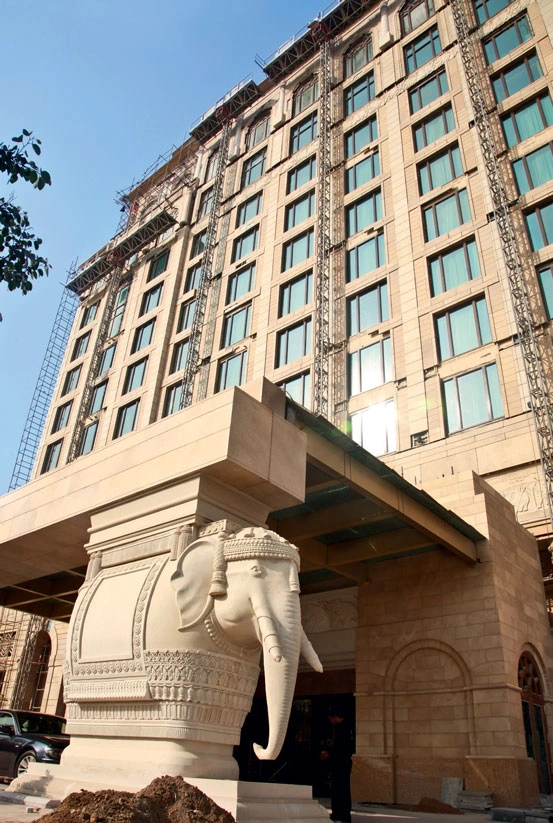
Nair snorts at this. “Isadore originally agreed that the hotels would be called The Leela Four Seasons. But then he backed out. I could not allow them to be called just Four Seasons. I would have been happy to work with them but now I think, why do I need a foreign partner?” (Nair began his hotels with a marketing tie-up with Kempinski that continues to date.)
To set the record straight, Nair wrote to Sharp after the book came out in 2009. His letter reads: “I wish to remind you that during our meeting in Bangkok, we agreed that the hotels we developed would carry the name The Leela Four Seasons Hotels. It is most regretful that my lawyer did not confirm this agreement in writing to you following this meeting and hence our subsequent separation.”
Nair still has Sharp’s reply, which makes no reference to the quarrel and only says: “How well I remember the interesting conversations we had and the times we spent together are very pleasant memories for me.”
SO NAIR CAN SUCCEED in his mission to create the Indian version of the Four Seasons?
Nair is clear that he wants to replicate the spirit of Four Seasons, rather than the appearance. If anything, his hotels’ in-your-face opulence is in stark contrast to Four Seasons’ understated appeal. The Leela Palace Kempinski New Delhi has gold-plated doors more than 12 feet high. Inside Jamavar, the Indian cuisine restaurant, hangs a sculpture of a giant, silver-plated elephant. Even the finger bowls at the restaurant are outsized. Again, at 550 square feet, the average room is the largest among luxury hotels.
Lind argues that the biggest challenge is teaching the staff why luxury hotels do things in a certain way. Like the extra wipes in toilets. (“For the psychological comfort of the guests.”) Instead of blindly following orders, Lind says he’d like each member of the staff to think on his or her feet and “become an independent unit of hospitality”.
The group is betting that guests will buy into the over-the-top Indian experience. Many new properties that have come up here recently—Four Seasons Hotel Mumbai, Aman New Delhi, or for that matter even the Trident in Gurgaon—are adopting the minimalist, clean lines that are in vogue globally.
Leela’s experience is that foreigners love the gilt and the exuberance. At the Udaipur property, Nair often gets local tailors to stitch poshaks (traditional Rajasthani attire) for the guests. “Almost 90% of our footfall is foreigners,” says Jit Bose, marketing manager at The Leela Palace Kempinski Bangalore. Nair says, “I want to give the best of Indian luxury. When you come to my hotel, you know you have arrived in India.”
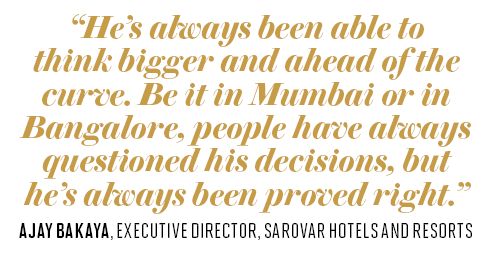
All very well, but there are more immediate matters to deal with: the debt, ITC’s stake in the Leela, and constant rumours that Nair’s sons do not get along.
Between October 2008 and December 2010, ITC Hotels, part of the Rs 5,000 crore ITC group, and a wholly-owned ITC subsidiary, Russell Credit, picked up an 11.51% stake (through a series of open market transactions) in Hotel Leelaventures, the company through which Nair controls his hotels. Incidentally, ITC also owns 14.98% in the Oberois’ East India Hotels. Speculation was rife that ITC was trying to take over the Leela Group but ITC said that this was just a portfolio investment. Since then, Nair has raised his stake in Leelaventures. Currently, it’s at 54.6%. “As long as I have 51%, no one can do anything,” says Nair. “In fact, let [ITC chairman] Yogi Deveshwar retire, I will offer him a place in my group. I can even give him a 2% share.” His face lights up at the thought of his supposed adversary working for him. “Why is it difficult? Yogi is not an owner, no?”
Reducing debt is also high on his agenda. Vivek says the group is looking at selling assets. “We have 270,000 square feet of commercial space in Chennai, for which we have already been offered around Rs 300 crore by several companies.” Also potentially on the block are four acres in Hyderabad’s posh Banjara Hills. “That will bring in another Rs 300 crore to Rs 350 crore. The debt can be easily managed,” says Vivek, adding that instead of building a property, they may manage another hotel in Hyderabad, talks for which have already begun. The Leela’s chief financial officer Krishna Deshika says they are looking at raising more equity capital to improve the debt-equity ratio.
But perhaps Nair’s masterstroke has been to convince sons Vivek and Dinesh, that, after him, neither brother should sell the family stake to an outsider without giving the other the right of first refusal.
IT IS EARLY EVENING at Nair’s 25,000-square-foot, ivy-draped Mumbai bungalow. He is talking about how one day he would like to purchase the Lanesborough (a leading hotel) in London. He’s equally excited about the new Rolls-Royce Ghost that he bought for his 89th birthday. It’s the same colour—azure—as his Rolls-Royce Silver Shadow, which he bought 19 years ago, when he turned 70.
Leela, who has inspired him all along, walks in. They have been married 65 years. Asked what more she would like him to do, she gives a little laugh, beams at him, and says with mock sternness: “No more! Now it’s time for the kids.”










Leave a Comment
Your email address will not be published. Required field are marked*